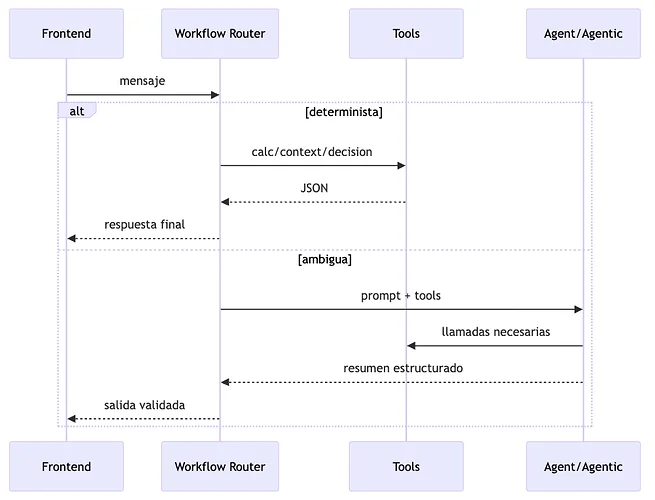Designing a Deterministic Workflow Router in Front of Your Agent
09-10-2025
In modern architectures that integrate language models, a recurring challenge is efficiently managing the multiple possible routes a user query can take. Escalating each message directly to an intelligent agent might seem like a general solution, but it involves significant costs in terms of tokens, latency, and traceability. To address this, a deterministic "Workflow Router" acts as a preliminary decision mechanism, classifying requests and applying routing logic based on intent, structure, and business rules.
This approach aims to preserve the balance between control, efficiency, and user experience, especially in systems operating in production under clear performance and audit constraints.
1. Why place a router in front
Not all queries require agent intervention. Many can be resolved directly with specific rules or tools. A router acting as an initial filter allows:
-
Reducing computational load and token cost.
-
Ensuring a quick response when the path is clear.
-
Protecting the agent from unwanted or erroneous inputs.
This approach is key for systems operating in production, where efficiency, traceability, and robustness are priorities.
2. Intent detection and rules
The router relies on classifiers or deterministic rules to identify the query's intent. It can use regular expressions, lightweight classifiers, or closed-category models. Examples of intents:
-
calc_x: calculate a specific value. -
get_status: retrieve status or context. -
faq_abierta: generic or ambiguous question.
The goal is to route each message to the most appropriate path according to its intended intent.
3. Data hygiene and validations
Before processing any route, the router must implement safeguards:
-
PII hygiene (personally identifiable information): detection and anonymization if applicable.
-
Input and output validation: use of JSON schemas to structure data and ensure consistency.
-
Post-processing: adjustments in the output to meet format, language, or security standards.
4. Timeouts, limits, and budgets
Every execution must respect:
-
Limits of steps or tools invoked.
-
Token budgets defined by route.
-
Configurable timeouts to avoid blockages.
This reinforces system stability and facilitates monitoring.
5. Minimum viable telemetry
A well-designed router should expose:
-
Classification logs and detected intent.
-
History of routes taken.
-
Validation results and captured errors.
This allows detecting usage patterns, possible routing errors, and optimization opportunities.
Example: hybrid flow with fast track

Comparative table by intent
| Intent | Source of truth | Tool | Validations | Expected SLA |
|---|---|---|---|---|
| calc_x | Local calculation | Embedded functions | Numeric JSON schema | <1s |
| get_status | Database | SQL query | Input sanitization | <1.5s |
| faq_abierta | N/A | Agent/Agentic | Semantic structure | <4s |
Implementation checklist
-
Intent classifier (regex, ML, or mixed).
-
Input/output JSON schemas by route type.
-
Operational limits per execution.
-
Logging of routes and errors.
Frequently asked questions
What if the classifier is wrong?
- A fallback mechanism should be defined (e.g., redirect to a generic route or request clarification).
Can an agent re-classify a query?
- In advanced architectures, yes. The agent can provide feedback to the system to improve future classification.
Conclusion
A well-designed Workflow Router is a fundamental piece for scaling conversational systems in a controlled and sustainable way. It allows combining efficiency, traceability, and adaptability in the same operational flow. The key is to implement clear classification logic, maintain strict validation contracts, and monitor the system to detect improvements.
This approach aligns with a lean development philosophy, like the one we apply at Lean Mind: build just enough, validate continuously, and scale when the value is clear.
